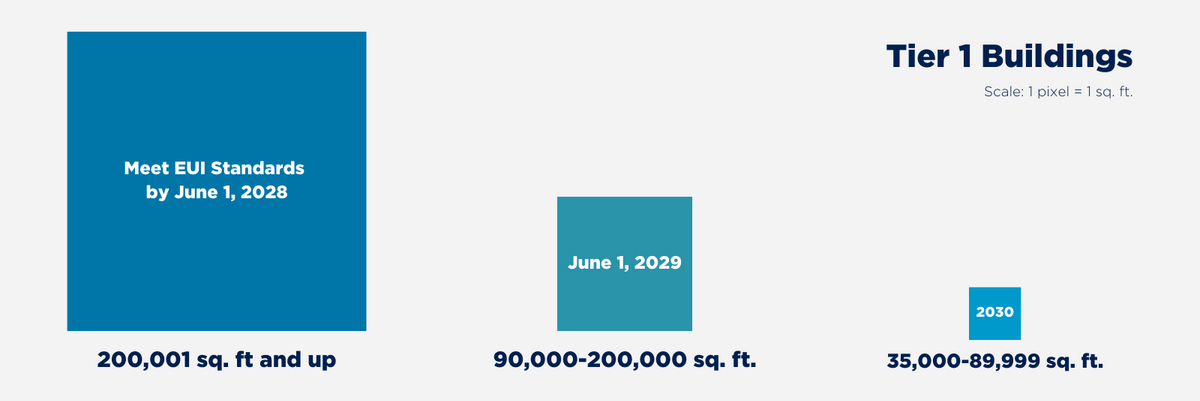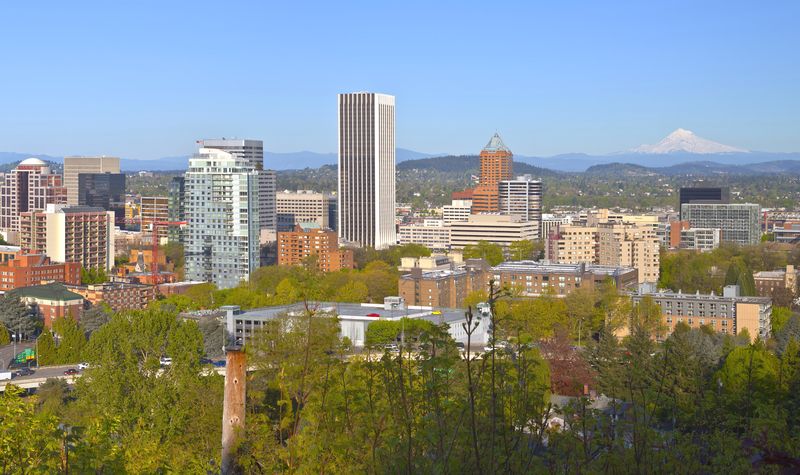Commercial, Energy Efficiency, GHG Emissions - August 30, 2023 - By Marshall Duer-Balkind, IMT
Ten Points on the Beaver State’s New Building Performance Standard
Oregon, the Beaver State, has joined the growing set of states taking ambitious climate action to improve buildings, becoming the fourth state to adopt a building performance standard (BPS). The BPS was part of House Bill 3409, which was signed into law by Governor Kotek on July 27, 2023. It’s a long bill, amalgamating a dozen or so proposals, so I am here to break down the key energy efficiency aspects for you! The bill also includes sections on green infrastructure, electric vehicles, tree canopies, renewable energy, climate resilience, algal blooms, and more, which I won’t get into here.
1. Oregon’s challenge: create a BPS without benchmarking data
With climate change clearly here in force, jurisdictions are setting aggressive carbon reduction goals, and moving quickly to implement them. Some of the first BPS laws that were created in places like New York City and Washington, DC had been collecting energy benchmarking data from all large buildings for years. But many jurisdictions with new BPS, including Washington State, Colorado, Maryland, and Vancouver (Canada), have moved directly to establish a BPS without having the benefit of historical data. Oregon now joins this cohort. Generally, jurisdictions have taken one of three paths to do so:
- Mandate data collection and wait to set specific standards until a specified future date;
- Conduct energy modeling and statistical analysis to estimate appropriate targets based on reference data sets, as Vancouver did; or,
- Use a national standard like ASHRAE 100, which contains reference targets for each climate zone, as Washington State did.
The Oregon BPS combines the first and third approaches, using ASHRAE 100 for larger buildings and waiting to determine targets for smaller ones.
2. Oregon’s BPS covers buildings over 20,000 sq. ft., in several waves
Oregon divided covered buildings into two buckets. The first tier (“Tier 1 buildings”) which is subject to near-term energy performance standards, includes non-residential and hotel/motel buildings over 35,000 square feet. Notably, it does not cover schools, university buildings, agricultural buildings, or energy-intensive structures like hospitals, manufacturing buildings, and agricultural buildings.

These buildings must meet energy use intensity (EUI) standards by a date certain, according to the following deadlines:
- Tier 1 buildings over 200,000 square feet: June 1, 2028
- Tier 1 buildings 90,000-200,000 square feet: June 1, 2029
- Tier 1 buildings 35,000-89,999 square feet: June 1, 2030
The specific standards have not been set, but are to be set through rulemaking based on median EUIs for each climate zone and building type listed in the ASHRAE 100 standard, as discussed in Point 3 below.
“Tier 2 buildings” include multifamily, and institutional buildings (hospitals, schools, universities, and so forth) over 35,000 square feet, and non-residential and hotel/motel buildings 20,000-35,000 square feet. These buildings must begin submitting data to the State, but no BPS is yet established for buildings in this group. The State Department of Energy must come back to the legislature to recommend a BPS approach for Tier 2 buildings by 2030.
Certain types of manufacturing and agricultural buildings are exempted entirely, and historic buildings of all sorts will be afforded significant flexibility.
3. How effective are ASHRAE 100-based standards at driving decarbonization?
Like Washington State, Oregon will use ASHRAE 100 as a base for its BPS for Tier 1 buildings. In IMT’s view, ASHRAE 100 can be a useful reference point for determining targets, especially when better local/regional data is not available. Moreover, using site EUI targets somewhat favors electrification with heat pumps, and are aligned with what a building owner actually sees–both reasons our BPS model law recommends Site EUI as a metric.
ASHRAE 100 offers two levels of EUI targets; one based on median performance and one based on 25th percentile (a building in the 25th percentile performs better than 75% of all buildings; this is the same conceptual threshold as ENERGY STAR certification, though the ENERGY STAR score takes into account many use factors and so the two are not directly comparable).
In Washington state, the eventual EUI targets that were set, in coordination with stakeholder feedback, varied from the default ASHRAE 100 median EUIs, and were more stringent than some and less than others. However, Seattle recently introduced a BPS law that will create a city-level program on top of the Washington state program in part because they did not foresee enough emissions savings coming from the state program. Modeling by the City of Seattle forecasts that the state program will reduce citywide GHGs by 4% by 2050, while the program they aim to adopt is forecast to reduce GHGs by an additional 27%! In short, deeper change with a BPS is possible.
The Oregon law requires that the EUI standards cannot be more stringent than the ASHRAE 100 median EUIs, which could limit the effectiveness of the program if not updated over time. IMT recommends that Oregon work to ensure the EUI standards are sufficiently rigorous to drive action, and that they be regularly updated as the performance of the building stock improves.
4. ASHRAE 100 is a standard, not a regulation
Additionally, ASHRAE 100 in its current form was intended as a technical standard that “provides criteria that will result in reduced energy consumption through improved energy efficiency and performance in existing buildings”. Washington State ended up incorporating substantial sections of ASHRAE 100 into their state regulations. This creates a compliance system that is quite complex and may be more expensive for buildings to comply with than needed.
For example, under ASHRAE 100, any building that does not meet the EUI standard must undertake an ASHRAE Level 2 energy audit, as defined by ASHRAE Standard 211. While a Level 2 audit is certainly best practice, in many cases it may be more extensive than what is needed.
While the committee overseeing ASHRAE 100 has shifted its Title, Purpose, and Scope (TPS) to “provid[e] a technical basis for setting building performance standards”, that will govern future versions of the standard, though not the one referenced by Oregon. IMT recommends that Oregon engage stakeholders to build upon the best aspects of ASHRAE 100 while avoiding pitfalls.
5. Community input
The state will establish and consult an advisory committee that includes “representatives of eligible building owners, tenants of covered commercial buildings, public utilities, organizations with experience in designing or implementing energy efficiency programs, local governments, organizations that focus on environmental justice and other stakeholders the department identifies as needing representation.” The Committee must be consulted in creating and amending any BPS rules.
In IMT’s view, this advisory committee as defined in the law is necessary, but insufficient to ensure that the BPS accurately reflects community priorities and protects frontline communities. Hopefully, the implementation phase sees deeper community engagement.
6. Local governments can still adopt their own BPS
Portland, Oregon has been working for years on a BPS that is grounded in community priorities. Fortunately, the state law supports this, as it explicitly allows municipalities to adopt energy or greenhouse gas performance standards so long as the standards are more stringent or apply more broadly than the state law, do not exceed the state building code for new buildings, and align with state rules where practical. This is a best practice for statewide BPS laws.
7. Deeper savings for new buildings
The law requires that the state establish energy efficiency goals for building codes to reduce energy use of new construction by 60% relative to the state’s 2006 codes. Moreover, BPS goals for recently constructed buildings may be based on statewide energy codes in effect when the building was built, (though whether this would result in building-specific targets or prototype model-based targets is unclear). This alignment can help address a fundamental challenge some BPS laws have seen where a building built to the code may not meet the BPS. Moreover, few buildings perform exactly as designed. Oregon’s requirement may provide outcome verification, and prompt greater care in design, construction, and operations.
8. Alignment with energy efficiency programs
One concern that sometimes comes up with BPS laws is that they could limit a building owner’s eligibility for certain energy efficiency incentives, since buildings would now be required to reduce their energy use. Fortunately, the Oregon law avoids this trap, by explicitly stating that the performance standard “does not change eligibility criteria for, or benefits or incentives available under, other programs for energy efficiency demand response.” Moreover, the law provides that revenue from civil penalties for non-compliance shall be allocated to the department’s energy efficiency programs, thus driving further investment.
9. National Building Performance Standard Coalition
Under the law, the state commits that it will join the National Building Performance Standard Coalition. Including this commitment in law sets Oregon apart, and emphasizes the momentum and traction of this important cohort of national climate leaders.
10. Ongoing heat waves make accelerating heat pump adoption critically important
In addition to creating a BPS, the law sets a goal of installing 500,000 heat pumps in Oregon by 2030 and creates new funding and outreach programs to support this. Now, this may seem like a very aggressive target, but it is quite in line with heat pump adoption rates in other leading states. Maine–a state a third the size of Oregon–made news recently by blowing past their 100,000 heat pump targets two years early, and aims to install 175,000 more by 2027.
Heat pump adoption will be particularly important for the “tier 2” buildings that won’t get a BPS until after 2030, and for the many residential buildings that are outside the scope of any BPS. And the efficiency of heat pumps will be critical to helping all buildings meet their targets. Moreover, many residential buildings in the Pacific Northwest have no air conditioning. This poses significant health dangers to Oregonians as the state sees record heat waves are expected to worsen with a warming climate. Many building owners will add mechanical cooling in the coming years; it is critically important to ensure this is done via energy-efficient heat pumps that can also provide low-carbon heating.
Ten Points on the Beaver States’ New Building Performance Standard originally appeared on the IMT website.
 Marshall Duer-Balkind is the Director of Policy Programs at IMT, where he works to develop and implement policies for driving high-performance buildings, grounded in community priorities and technical quality. Marshall is an international expert in policies and technologies to improve the energy and carbon performance of buildings and communities, with over a dozen years of experience in the for-profit, government, and non-profit sectors. Marshall is a key contributor to the first building performance standard programs in both the U.S. and Canada, as Co-Chair of Washington, DC’s Building Energy Performance Standards Task Force, and a member of the City of Vancouver’s Carbon Pollution Limits Technical Advisory Committee. Marshall holds a Master’s of Environmental Management degree from the Yale School of the Environment, and Bachelor’s degree in Political Science and Computer Science from Oberlin College. He is proudly born and raised in Washington, D.C.
Marshall Duer-Balkind is the Director of Policy Programs at IMT, where he works to develop and implement policies for driving high-performance buildings, grounded in community priorities and technical quality. Marshall is an international expert in policies and technologies to improve the energy and carbon performance of buildings and communities, with over a dozen years of experience in the for-profit, government, and non-profit sectors. Marshall is a key contributor to the first building performance standard programs in both the U.S. and Canada, as Co-Chair of Washington, DC’s Building Energy Performance Standards Task Force, and a member of the City of Vancouver’s Carbon Pollution Limits Technical Advisory Committee. Marshall holds a Master’s of Environmental Management degree from the Yale School of the Environment, and Bachelor’s degree in Political Science and Computer Science from Oberlin College. He is proudly born and raised in Washington, D.C.
Read These Related Articles:
- Energy Codes Forecast 2024: Money, Politics, and a New Model Code
- With New Law, California Moves Towards Statewide Building Performance Standard
- Energy Codes: The Year in Review and a Look Ahead
- SED Welcomes ENERGY STAR, iMasons, IMT, Ratio Institute, and Second Nature to the Net Zero Forum
- The Role of Buildings in the 2022 IPCC Report
Share this valuable information with your colleagues using the buttons below:
« Back to NewsStay Up-To-Date












